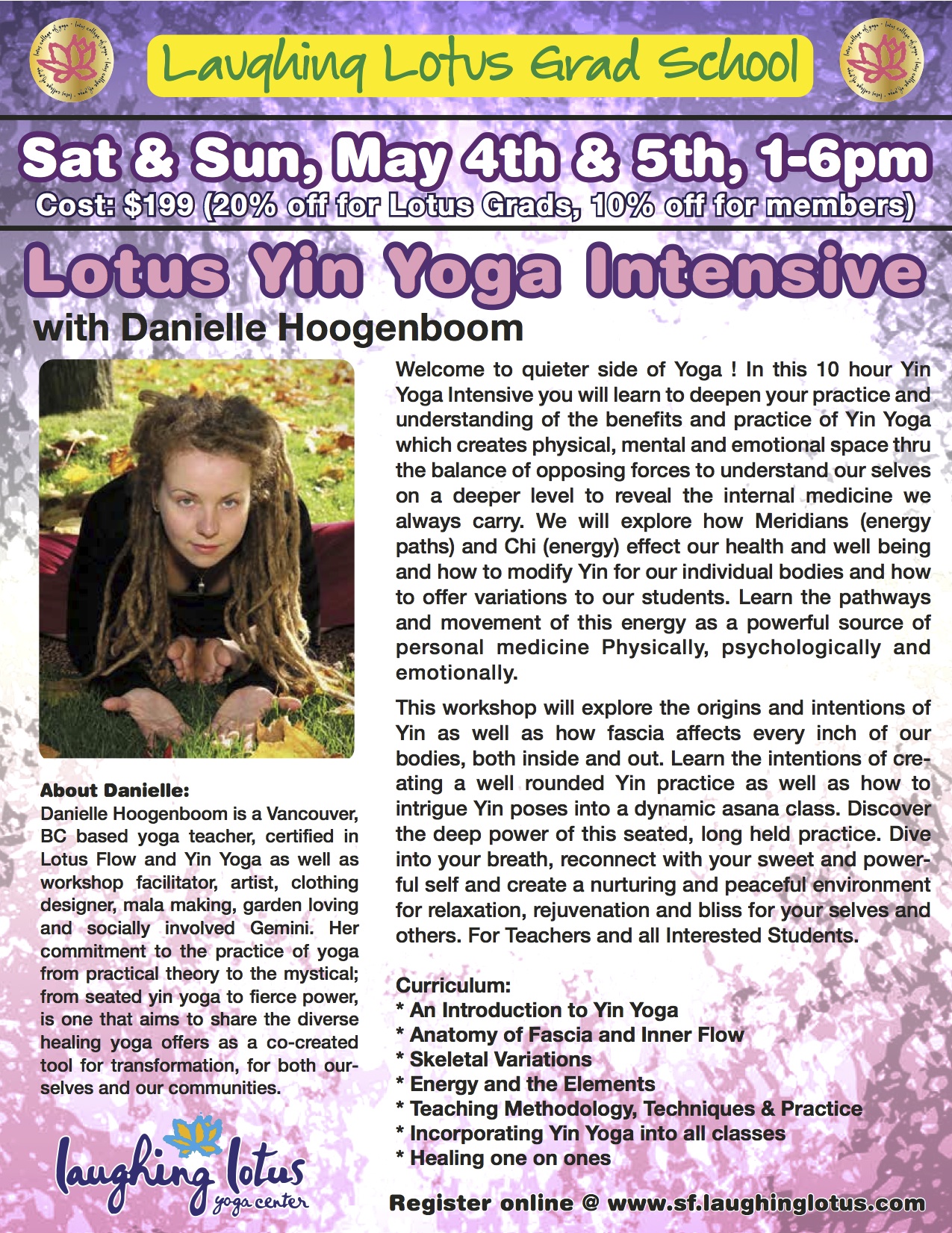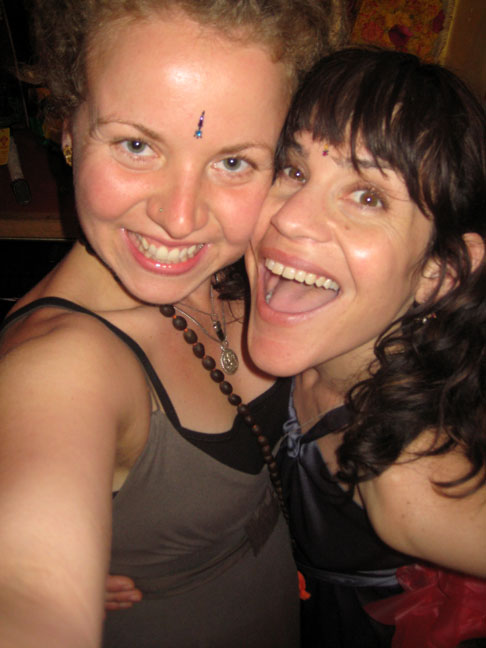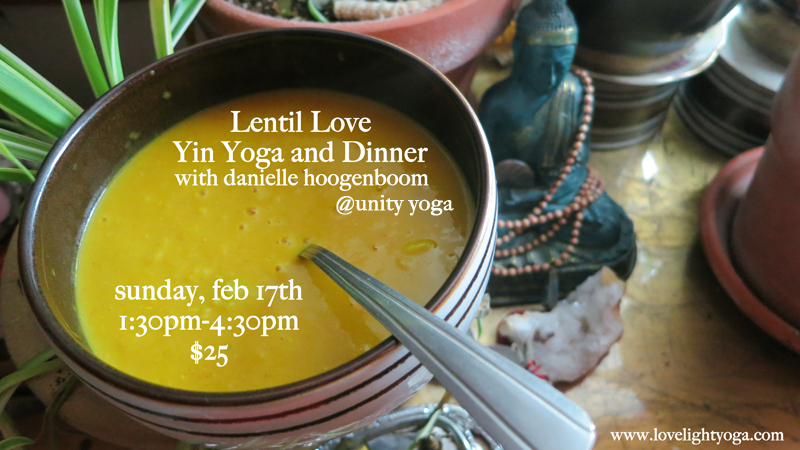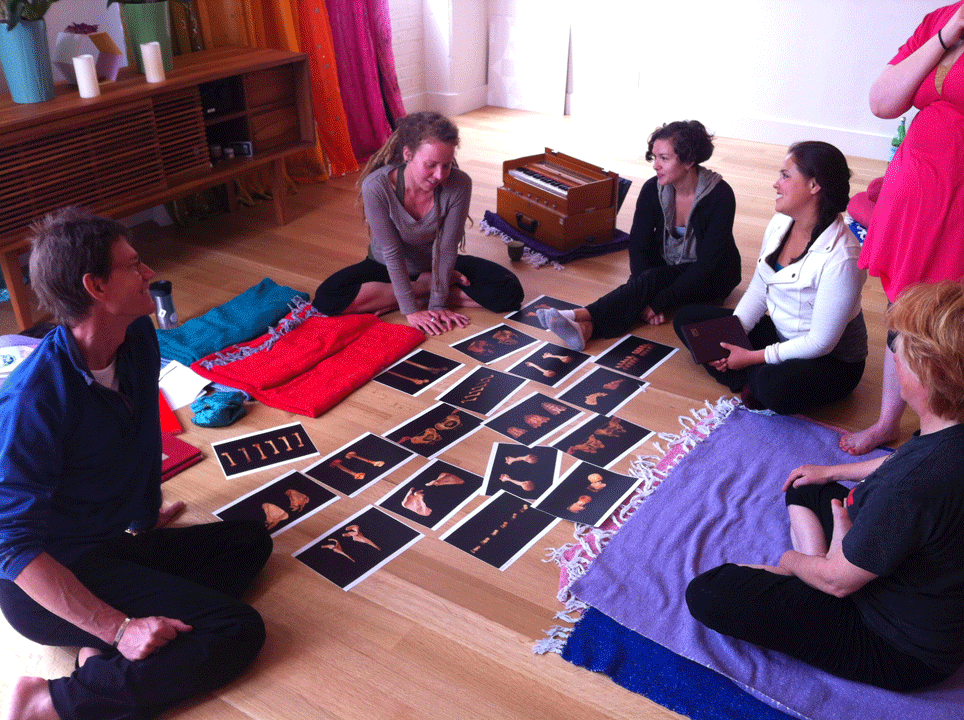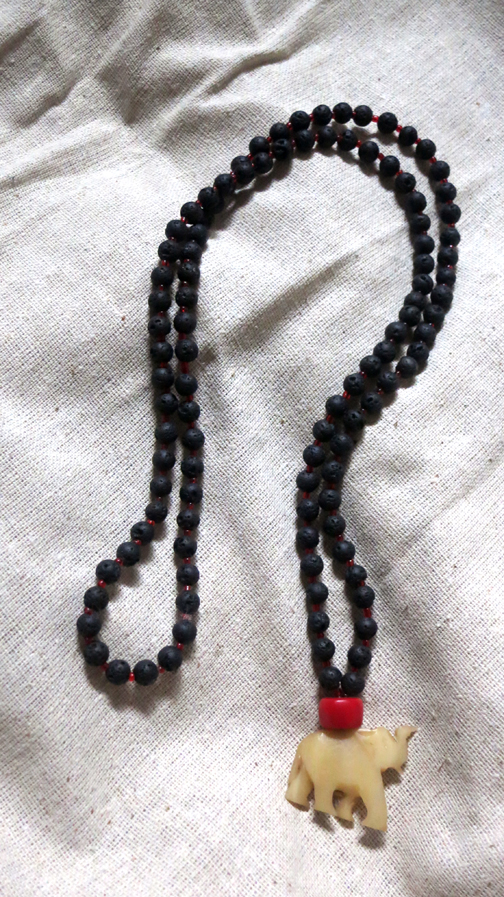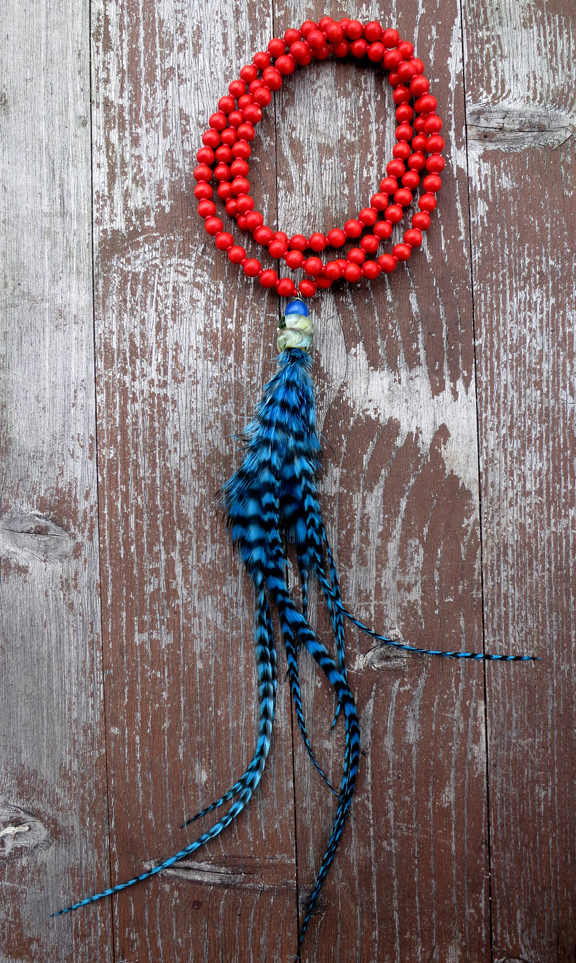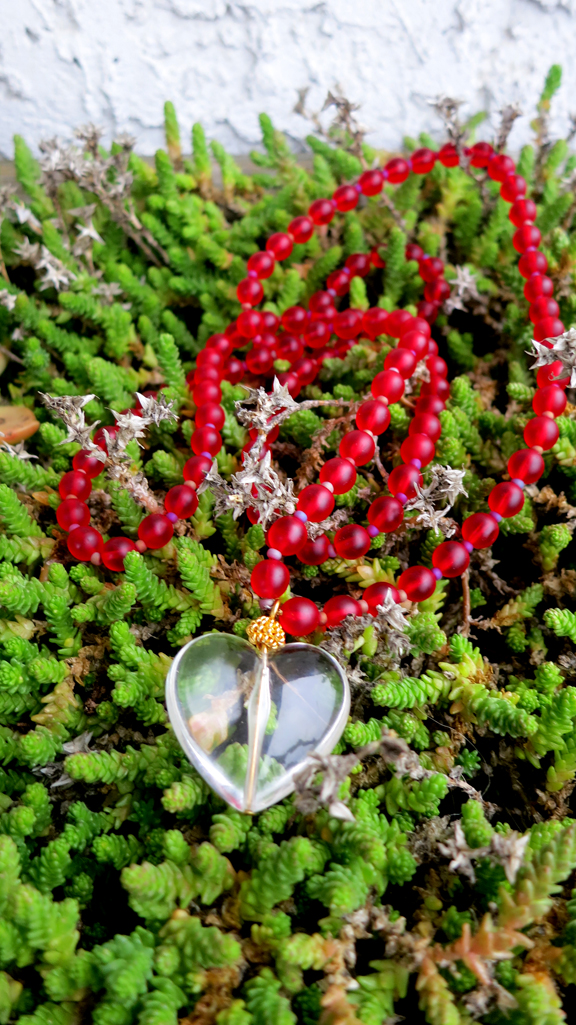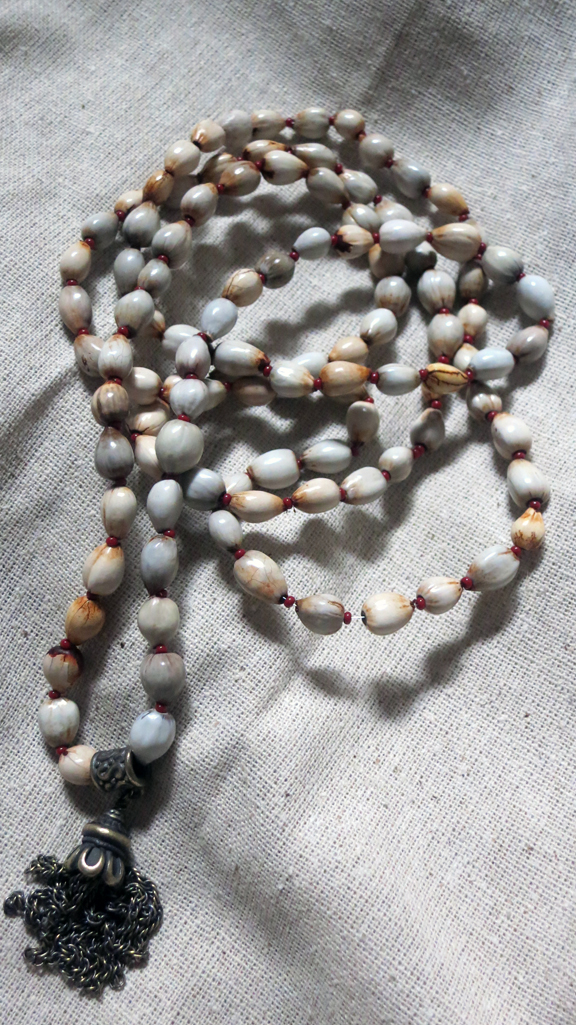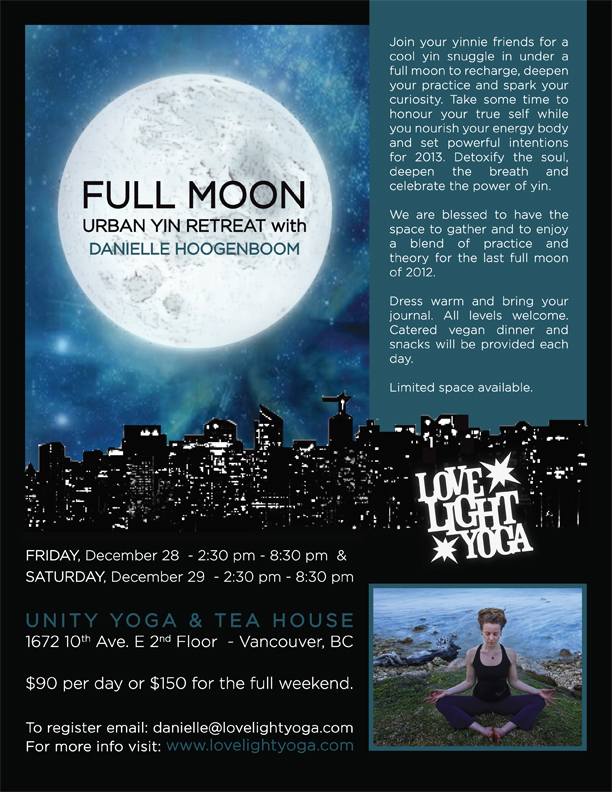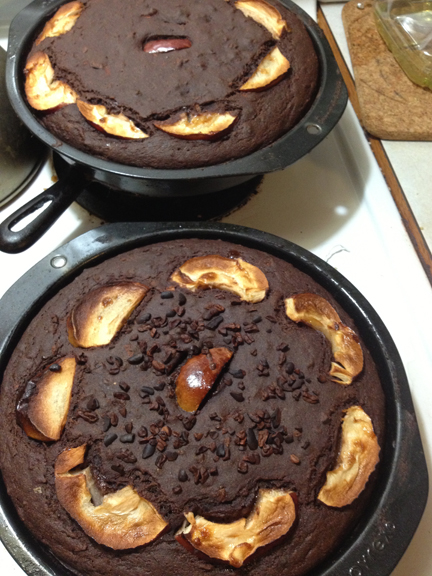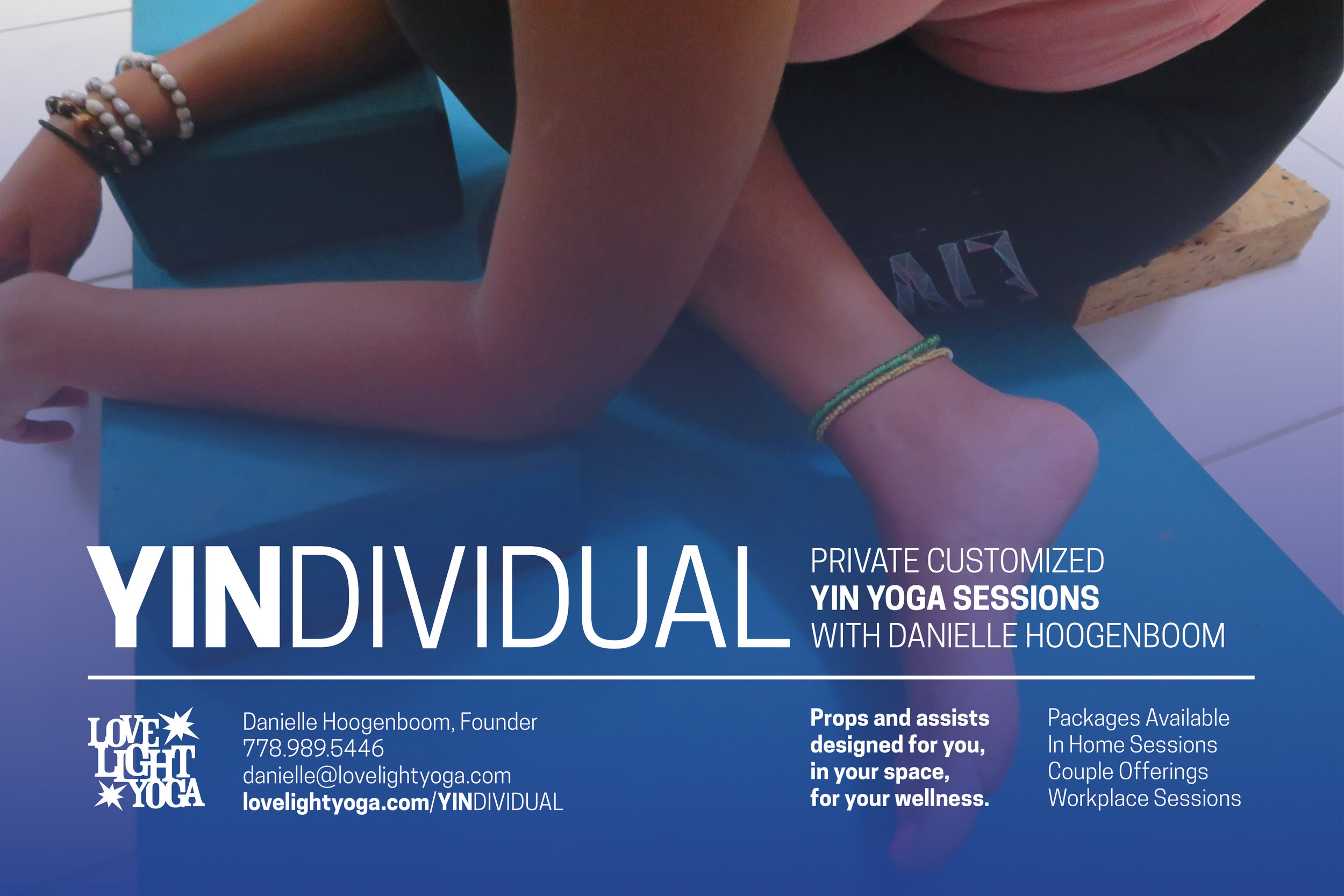Lentil Love: Yin and Dinner in Vancouver
/Join us at Unity Yoga in Vancouver on June 9th for an afternoon of yummy yin in the sunshiney and cozy studio. Lets fill your hearts with self love, nourish the body with delicious yin, soothe the mind with meditation and our tasty breathe. Marinate in your own sweet self, and let the juices of life flow through you freely. Then of course, post rest...lets rise up and join together in some organic vegan curried lentils. Full heart, full body, full spirit.
BYOB (bring your own bowl, spoon too!) 
Tea and soup served. Mats provided.
Unity Yoga (10th and Commercial)
Sunday, June 9th
1:30-4:30pm
$30 +tax
Advanced YIN Studies at Laughing Lotus SF
/Lotus Yin Discovery with Danielle Hoogenboom
May 4th and 5th
Laughing Lotus in SF
Dates: Sat. May 4th & Sun. May 5th Times: 1-6pm Cost: $199 (20% off for Lotus Grads)
Welcome to quieter side of Yoga ! In this 10 hour Yin Yoga Intensive you will learn to deepen your practice and understanding of the benefits and practice of Yin Yoga which creates physical, mental and emotional space thru the balance of opposing forces to understand our selves on a deeper level to reveal the internal medicine we always carry. We will explore how Meridians (energy paths) and Chi (energy) effect our health and well being and how to modify Yin for our individual bodies and how to offer variations to our students. Learn the pathways and movement of this energy as a powerful source of personal medicine Physically, psychologically and emotionally.
This workshop will explore the origins and intentions of Yin as well as how fascia affects every inch of our bodies, both inside and out. Learn the intentions of creating a well rounded Yin practice as well as how to intrigue Yin poses into a dynamic asana class. Discover the deep power of this seated, long held practice. Dive into your breath, reconnect with your sweet and powerful self and create a nurturing and peaceful environment for relaxation, rejuvenation and bliss for your selves and others. For Teachers and all Interested Students.
Curriculum: * An Introduction to Yin Yoga * Anatomy of Fascia and Inner Flow * Skeletal Variations * Energy and the Elements * Teaching Methodology, Techniques & Practice * Incorporating Yin Yoga into all classes * Healing one on ones
About Danielle: Danielle Hoogenboom is a Vancouver, BC based yoga teacher, certified in Lotus Flow and Yin Yoga as well as workshop facilitator, artist, clothing designer, mala making, garden loving and socially involved Gemini. Her commitment to the practice of yoga from practical theory to the mystical; from seated yin yoga to fierce power, is one that aims to share the diverse healing yoga offers as a co-created tool for transformation, for both ourselves and our communities.
Lentil Love: Yin Yoga and Dinner
/
Join us for a warm, cozy and nurturing Sunday afternoon. Dive deep into your own practice and self care for a 2.5 hour Yin Yoga practice and meditation, then stay for dinner of vegan lentil stew with your chilled out yinnie friends.
Its an important season to really rest and nourish the body. Slow down, breath deep, let go. Retreat to advance, nourish the cycles and find stillness. Yin Yoga is very much an practice for organ health, our practice will focus on caring for the Kidney and Urinary Bladder meridians for this winter season.
Sunday, February 17th.
1:30-4:30pm
Unity Yoga, Vancouver. BC
$25
pre reg: danielle@lovelightyoga.com & the event on facebook here
Yin Monthly on Feb 2nd: Skeletal Variations
/Yin Yoga Monthly at East Side Yoga, Vancouver. BC
Join Danielle for an examination of bones with all of their wonderful variations to see how this can effect your yoga practice. Our focus will be on yin, but This workshop is inspired from my work in completing my 500 hour Yin Yoga Teacher Training with Paul and Suzee Grilley.
We will look at how to make yin yoga accessible to all bodies and begin the journey of recognizing all the variations of poses that could work for different bones. Dive into your practice to understand more thoroughly how to create a yin shape just for you, and as well as how to apply this work in your classes as a teacher of both seated and dynamic asana. Open to all levels from yin virgins to teachers.
East Side Yoga
Saturday, February 17th, 2013.
1:30pm-4:30pm
$30
Yin Workshops: Jan and Feb in Vancouver
/Yin and Fascia with Danielle Hoogenboom and Harmony Shire, RMT.
January 12th, 2013 at East Side Yoga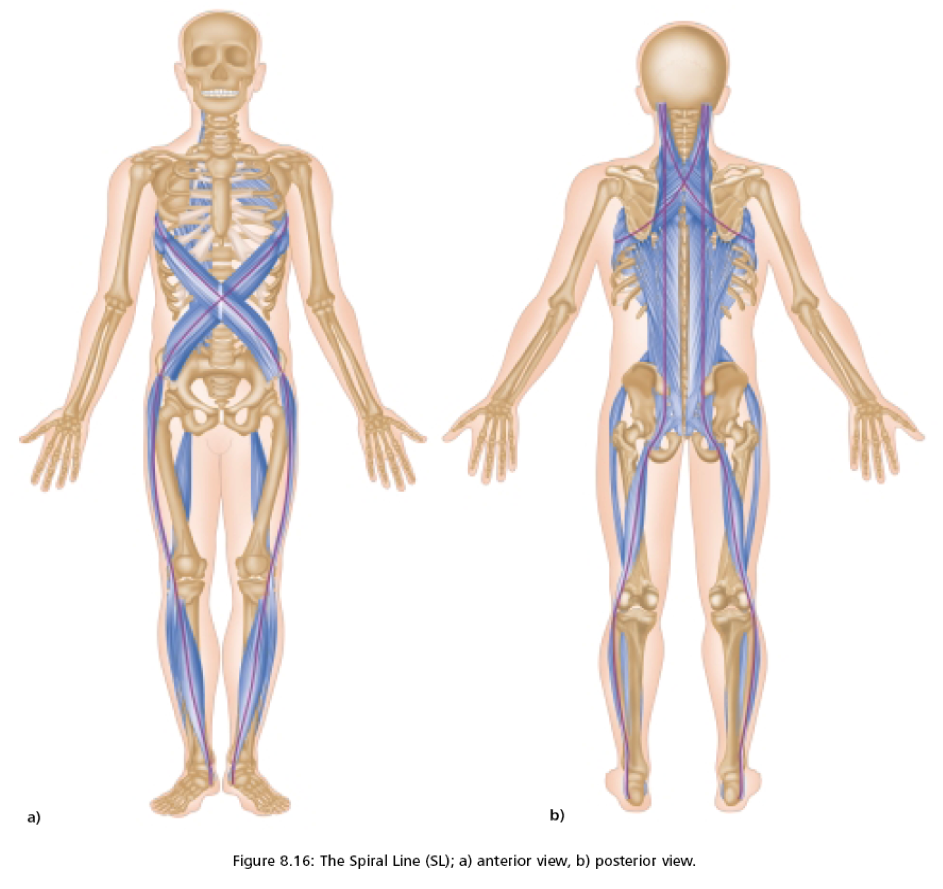
1:30pm-4:30pm
The fascial system is the system of tissue responsible for the postures we hold in everyday life. Without it, our bodies would be a puddle of tissue on the ground unable to function. When fascia thickens from injuries and everyday habits, it produces chronic pain from the inability to stretch and move with its surroundings. The better the form of the fascia and posture, the more fluid and effortless are the functions of fascia and all the tissues it holds, including organs, nerves, blood vessels, muscles, bones, and brain and spinal cord. We will examine fascia in the practice of Yin Yoga how it encourages an opening in the deeper fascial tissues, allowing freedom for movement of the deeper structures of the body, such as bones, ligaments, joint capsules, and tendons, which then provides more space for the surrounding tissues to rest and move more comfortably, thus reducing and preventing chronic pain.
The Power of the Water Snake: Kidneys and Bladder
February's Yin Monthly at East Side Yoga will examine and celebrate the Chinese New Year 2013 as a transition into the year of the Water Snake. Water is the element of the Kidney and Bladder meridians, as well as the organs and energy of winter. We will look at a balanced practice to strengthen the power of our inner wisdom and nourish our winter organs for optimal harmony in body, mind and spirit.
February 2nd, 2013 at East Side Yoga
1:30pm-4:30pm
$30
Sunday, February 17th @Unity Yoga
1:30pm-4:30pm
$45
Welcome into the New Year with the invoked power of Yin Yoga and Acupuncture. We will examine the nature of practice of energetic work and how they can work together to create a powerful internal shift. Join Danielle Hoogenboom and Registered Acupuncturists for a workshop on theory, followed by yin yoga and community acupuncture. Uplift your spirits, balance your energy and strengthen your sense of community while doing it!
Homemade Malas and Sacred Objects
/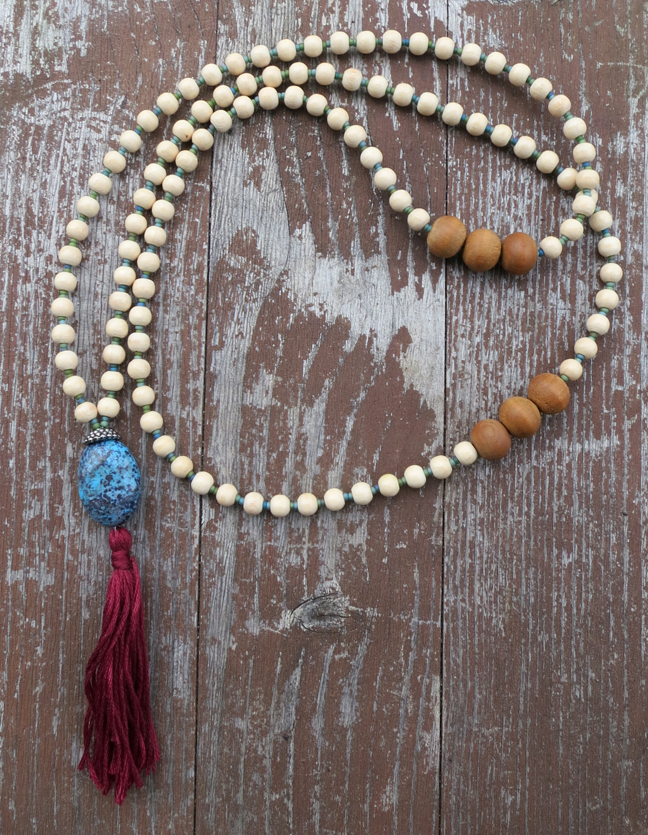 Greetings, I am stoked to finally be sharing these images with you, and some of the sacred projects I have been working on . I have been making my own malas, or prayer beads for a few years. Its a special practice to set intentions, collect resources that empower what you are looking for in your life, (more fire, more balanced wood, clarity, etc) and then meditate on the ways in which you can combine these pieces to create something meaningFULL and powerFULL!
Greetings, I am stoked to finally be sharing these images with you, and some of the sacred projects I have been working on . I have been making my own malas, or prayer beads for a few years. Its a special practice to set intentions, collect resources that empower what you are looking for in your life, (more fire, more balanced wood, clarity, etc) and then meditate on the ways in which you can combine these pieces to create something meaningFULL and powerFULL!
This making with my hands, the beauty of collecting, finding, receiving and reclaiming the materials has been a meditation in action. It calls my mind to come to its still centre, its place of power and the arena in which intention can infuse the pieces with strength and spirit. I take my power back with these handmade/homemade malas, I call back my strength and my abilities as an intuitive being, a natural mystic and capable of creating/ receiving/offering my own forms of spiritual medicine. Jai!
Malas, or Japa Malas are used for the repetition of mantras, prayers, or sacred words. The beads help keep count of the prayers, but more importantly offer a physical act (touching each bead for each word/prayer) that helps steady the mind and charge the centre bead/beads (often called the prayer bead) Mantra has been described to me as mind tool, a way to refine and sharpen this tool in balanced way. I also believe that malas can hold powerful intentions and strength because we infuse with this devotion and appreciation. I think of my malas kind of like a new age blankie ( you know, your sacred blanket as a wee one!). It calms, cools and reminds us of our own inner sanctuary and peace.
The natural progression of making myself charged and special malas for years, calling in and creating that I need in that moment is that I started to receive requests to make malas for others in my life. This is where I am at now! I am making malas by request for friends and students, and also making, making, making and seeing whom they call to them. Its been an amazing, meditative and creative practice that is both fuelling and nourishing, but also an important part of my own devotional yoga practice....gratitude!
The History and Meaning of Prayer Beads (from the museum of anthropology website)
Over two-thirds of the world's population employ prayer beads as part of their religious practices. Prayer beads have a variety of forms and meanings, but the basic purpose is the same: to assist the worshiper in reciting and counting specific prayers or incantations. Christianity, Islam, Buddhism, and Hinduism are the major religions that use prayer beads in important ritualistic roles.
Beads have long been linked with the act of prayer. The English word bead is derived from the Anglo-Saxon words bidden ("to pray") and bede ("prayer"). The use of beads in prayer appears to have originated with Hindu religious practices in India , possibly around the 8th century B.C.E. Buddhism, which developed from a sect of Hinduism, retained the use of prayer beads as it became established in China, Korea, Japan, and Tibet. It is thought that Islam adopted prayer beads through contact with Buddhism and Hinduism. Prayer beads, in the form of the Catholic rosary, were common throughout Europe by the late Middle Ages
Hindu and Buddhist Mala
Hinduism, one of the oldest living religions, is the major religion of the Indian subcontinent. The two main branches of modern Hinduism—Shaivism and Vishnuism—employ different types of prayer beads, or mala. Shaivists, who are devotees of the god Siva, carry strings of 32 to 108 rudrakshabeads made from the seeds of a tree unique to the island of Java in Indonesia. These rough seeds represent the difficult and rigid life required of the worshippers of Siva. Each seed is segmented into five sections, which represent the five faces and personalities of Siva. Vishnu mala consist of carved wooden beads from the sacred basil shrub, or tulsi, and are usually found in strands of 108.
Buddhist mala also typically consist of strands of 108 beads, reflecting the religion's historical connection to Hinduism. In Buddhism, the 108 beads represent the impurities or lies that one must overcome in order to reach Nirvana. Most monks wear 108 beads for use in counteracting their 108 impurities, whereas lay people tend to wear only 30 or 40 beads. The difference in the number of beads used is a result of the spiritual differences in what different people must overcome or how far they have come on the path to enlightenment. Buddhist prayer beads have traditionally been made from the wood or seeds of the sacred Bodhi tree. As Buddhism spread throughout China, Korea, Japan, and Tibet, it was influenced by the various cultures of those areas and a number of new materials such as bone, amber, and semi-precious stones began to be used for prayer beads.
Traditionally, a mala or string of prayer beads composes of 108 beads. There are a pile of reasons why 108 is the number (traditionally its 108 beads for Buddhist and Hindus Malas) Below is a list by Swami Jnaneshvara Bharati of why 108 is a sacred number from this website
9 times 12: Both of these numbers have been said to have spiritual significance in many traditions. 9 times 12 is 108. Also, 1 plus 8 equals 9. That 9 times 12 equals 108.
Powers of 1, 2, and 3 in math: 1 to 1st power=1; 2 to 2nd power=4 (2x2); 3 to 3rd power=27 (3x3x3). 1x4x27=108
Harshad number: 108 is a Harshad number, which is an integer divisible by the sum of its digits (Harshad is from Sanskrit, and means "great joy")
Desires: There are said to be 108 earthly desires in mortals.
Lies: There are said to be 108 lies that humans tell.
Delusions: There are said to be 108 human delusions or forms of ignorance.
Heart Chakra: The chakras are the intersections of energy lines, and there are said to be a total of 108 energy lines converging to form the heart chakra. One of them, sushumna leads to the crown chakra, and is said to be the path to Self-realization.
Sanskrit alphabet: There are 54 letters in the Sanskrit alphabet. Each has masculine and feminine, shiva and shakti. 54 times 2 is 108.
Pranayama: If one is able to be so calm in meditation as to have only 108 breaths in a day, enlightenment will come.
Upanishads: Some say there are 108 Upanishads, texts of the wisdom of the ancient sages.
Sri Yantra: On the Sri Yantra there are marmas where three lines intersect, and there are 54 such intersections. Each intersections has masculine and feminine, shiva and shakti qualities. 54 times 2 equals 108. Thus, there are 108 points that define the Sri Yantra as well as the human body.
Pentagon: The angle formed by two adjacent lines in a pentagon equals 108 degrees.
Marmas: Marmas or marmasthanas are like energy intersections called chakras, except have fewer energy lines converging to form them. There are said to be 108 marmas in the subtle body.
Time: Some say there are 108 feelings, with 36 related to the past, 36 related to the present, and 36 related to the future.
8 extra beads: In doing a practice of counting the number of repetitions of the mala, 100 are counted as completed. The remaining are said to cover errors or omissions. The 8 are also said to be an offering to God and Guru.
Chemistry: Interestingly, there are about 115 elements known on the periodic table of the elements. Most of those, around or higher than the number 100 only exist in the laboratory, and some for only thousandths of a second. The number that naturally exist on Earth is around 100.
Astrology: There are 12 constellations, and 9 arc segments called namshas or chandrakalas. 9 times 12 equals 108. Chandra is moon, and kalas are the divisions within a whole.
River Ganga: The sacred River Ganga spans a longitude of 12 degrees (79 to 91), and a latitude of 9 degrees (22 to 31). 12 times 9 equals 108.
Planets and Houses: In astrology, there are 12 houses and 9 planets. 12 times 9 equals 108.
Goddess names: There are said to be 108 Indian goddess names.
Gopis of Krishna: In the Krishna tradition, there were said to be 108 gopis or maid servants of Krishna.
1, 0, and 8: Some say that 1 stands for God or higher Truth, 0 stands for emptiness or completeness in spiritual practice, and 8 stands for infinity or eternity.
Sun and Earth: The diameter of the Sun is 108 times the diameter of the Earth. The distance from the Sun to the Earth is 108 times the diameter of the Sun.
Moon and Earth: The average distance of the Moon from the Earth is 108 times the diameter of the Moon.
Silver and the moon: In astrology, the metal silver is said to represent the moon. The atomic weight of silver is 108.
Numerical scale: The 1 of 108, and the 8 of 108, when added together equals 9, which is the number of the numerical scale, i.e. 1, 2, 3 ... 10, etc., where 0 is not a number.
Meditations: Some say there are 108 styles of meditation.
Breath: Tantra estimates the average number of breaths per day at 21,600, of which 10,800 are solar energy, and 10,800 are lunar energy. Multiplying 108 by 100 is 10,800. Multiplying 2 x 10,800 equals 21,600.
Paths to God: Some suggest that there are 108 paths to God.
Smaller divisions: The number 108 is divided, such as in half, third, quarter, or twelfth, so that some malas have 54, 36, 27, or 9 beads.
Hinduism: 108 is said to refer to the number of Hindu deities. Some say that each of the deities has 108 names.
Islam: The number 108 is used in Islam to refer to God.
Jain: In the Jain religion, 108 are the combined virtues of five categories of holy ones, including 12, 8, 36, 25, and 27 virtues respectively.
Sikh: The Sikh tradition has a mala of 108 knots tied in a string of wool, rather than beads.
Buddhism: Some Buddhists carve 108 small Buddhas on a walnut for good luck. Some ring a bell 108 times to celebrate a new year. There are said to be 108 virtues to cultivate and 108 defilements to avoid.
Chinese: The Chinese Buddhists and Taoists use a 108 bead mala, which is called su-chu, and has three dividing beads, so the mala is divided into three parts of 36 each. Chinese astrology says that there are 108 sacred stars.
Stages of the soul: Said that Atman, the human soul or center goes through 108 stages on the journey.
Meru: This is a larger bead, not part of the 108. It is not tied in the sequence of the other beads. It is the quiding bead, the one that marks the beginning and end of the mala.
Dance: There are 108 forms of dance in the Indian traditions.
Praiseworthy souls: There are 108 qualities of praiseworthy souls.
First man in space: The first manned space flight lasted 108 minutes, and was on April 12, 1961 by Yuri Gagarin, a Soviet cosmonaut.
December: Urban Yin Retreat in Vancouver
/Friday, December 28 2:30-8:30pm and Saturday, December 29. 2:30-8:30pm
Unity Yoga 1672 10th Ave E 2nd floor Vancouver.
Join your yinnie friends for a cool yin snuggle in under a full moon to recharge, deepen your practice and spark curiosity. Take some time to honour the year your true self while you nourish your energy body and set powerful intentions for 2013. Detoxify the soul, deepen the breath and celebrate the power of yin. We are blessed to also gather together for the last full moon of the 2012. Part practice & part theory/study. Dress warm and bring a notebook. All levels. Catered dinner and snacks included from External Abundance. Come for both days or one.
Limited space.
register: danielle@lovelightyoga.com
Chocolate Vegan Cake Recipe, well tested!
/So it seems that its fall again for sure...that deep rooted urge to stay home and bake delicious things, while warming my apartment with the glow of a hot oven. I find myself making this recipe weekly, and freezing slices for later. Its originally a muffin recipe, but I am all about making it a dense cake...or cakes...I double the recipe (2 cakes are always better than one)
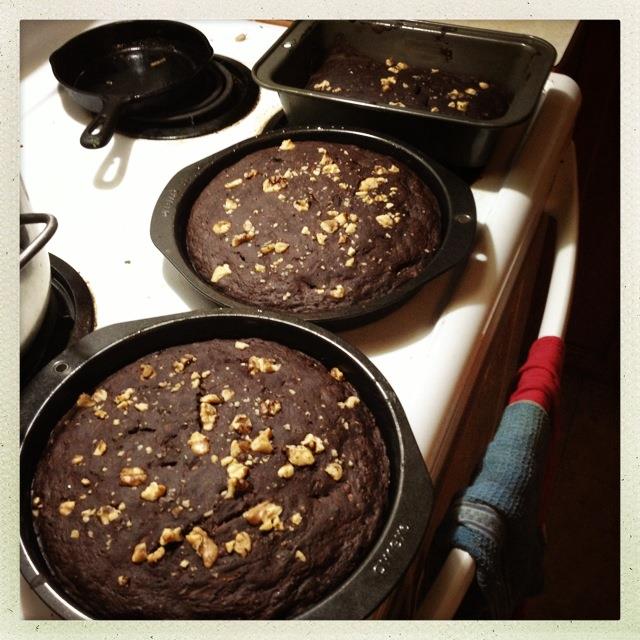
this recipe is from this site, I bracketed my inserts and variations!
1 flax egg (1 tbsp ground flax + 3 tbsp water)
1 & 1/4 cup lightly packed shredded zucchini, skin left on (or equal amount of grated apple!)
1 & 1/4 cup almond milk
2 tsp apple cider vinegar (or lemon juice)
3 tbsp pure maple syrup
1 tsp vanilla extract ( or mint extract with great with zucchini and chocolate, or I replace the vanilla with cinnamon if adding apple instead)
2 cups whole wheat pastry flour
1/3 cup cocoa powder
1 tbsp baking powder
1 tsp baking soda
1/2 tsp fine grain sea salt
1/2 cup cane sugar
1/3 cup dark chocolate chips (I use cocoa nibs instead)
2/3 cup walnuts, chopped ( I leave them out, and add more chocolate!)
(set aside, two large bowls: one wet, one dry & two smaller bowls, one for vegan egg mix, and one for vegan buttamilk)
1. Preheat oven to 350F and lightly spray muffin with oil or grease with Earth Balance.
2. Mix flax egg in a small bowl and set aside. Grate zucchini using a grater box (regular grate size). Set aside.
3. Mix almond milk and apple cider vinegar (or sub fresh lemon juice) in a small bowl and set aside. It will curdle, but this is the point as we’re making vegan buttermilk.
4. In a large mixing bowl, mix together the dry ingredients (flour, cocoa powder, baking powder, baking soda, salt, and sugar).
5. Mix together the wet ingredients (flax egg, almond milk mixture, maple syrup, and vanilla) and then pour over dry ingredients. Stir until just combined. Fold in the chocolate chips, walnuts, and shredded zucchini.
6. Spoon batter into prepared muffin tin filling each tin 3/4 of the way full. Bake for about 15-17 minutes at 350F, or until muffins slowly spring back when touched. (I bake the cakes for about 30, test with a knife) A toothpick should come out mostly clean. Cool in tin for 5 minutes. With a knife, loosen around the muffin edge and transfer to a cooling rack until completely cool.
Celebrate Uganda 2013
/Calling all passionate, engaged, and creative people to join the Celebrate Uganda 2013 team and travel with us to Uganda in January of 2013


